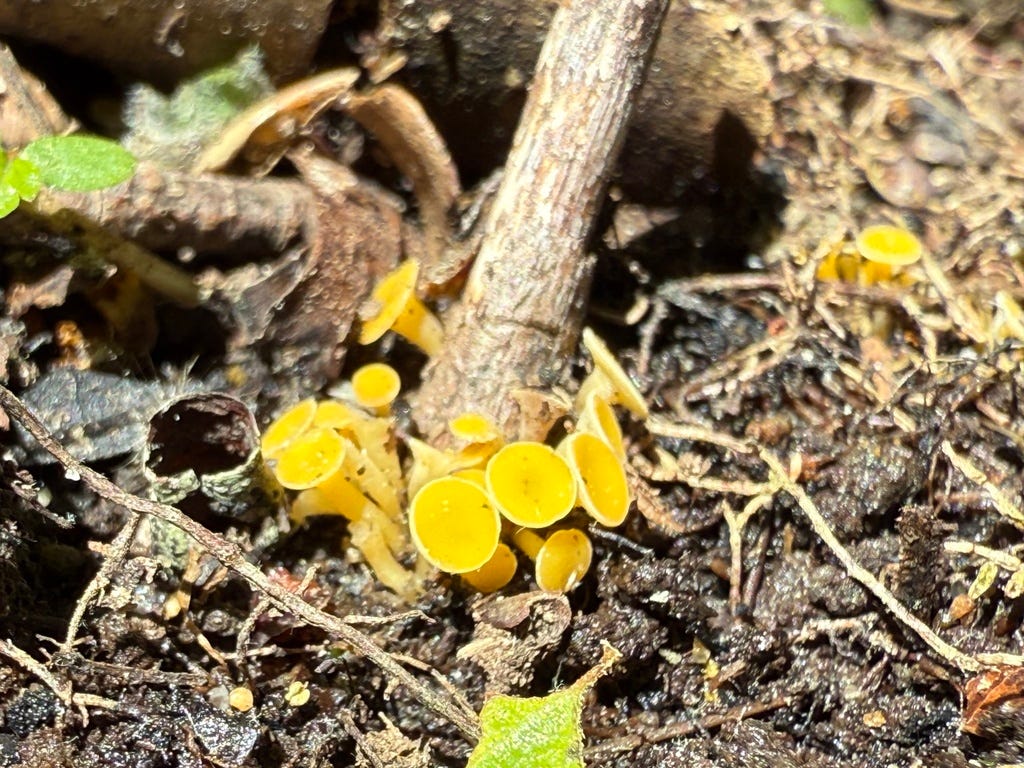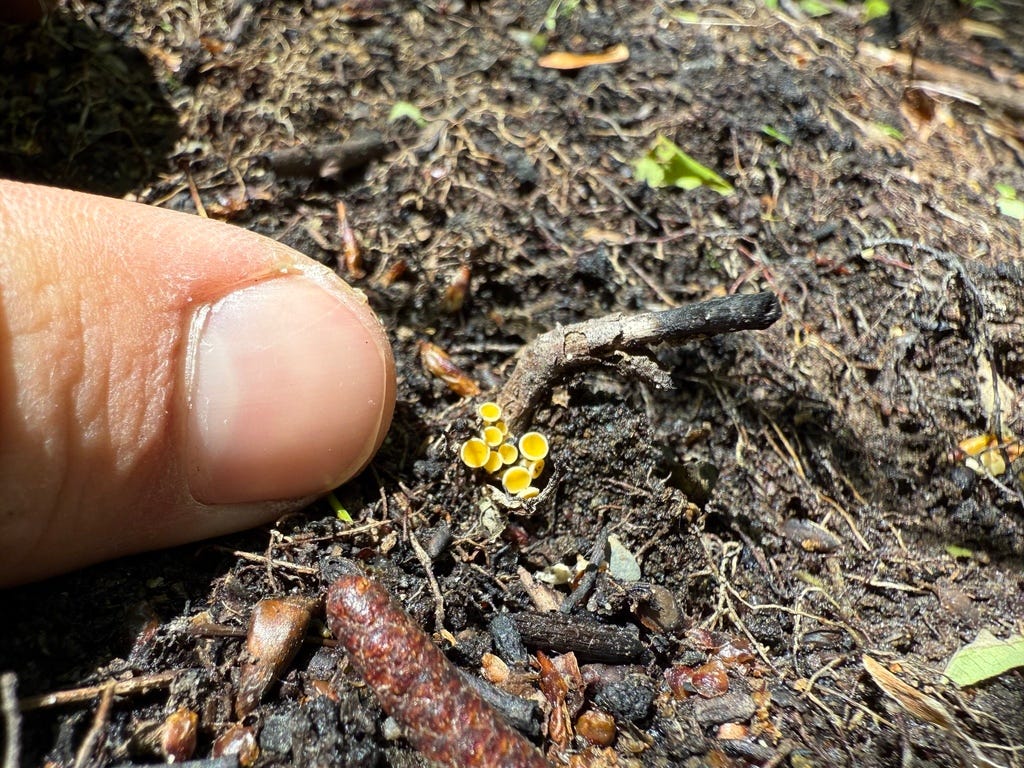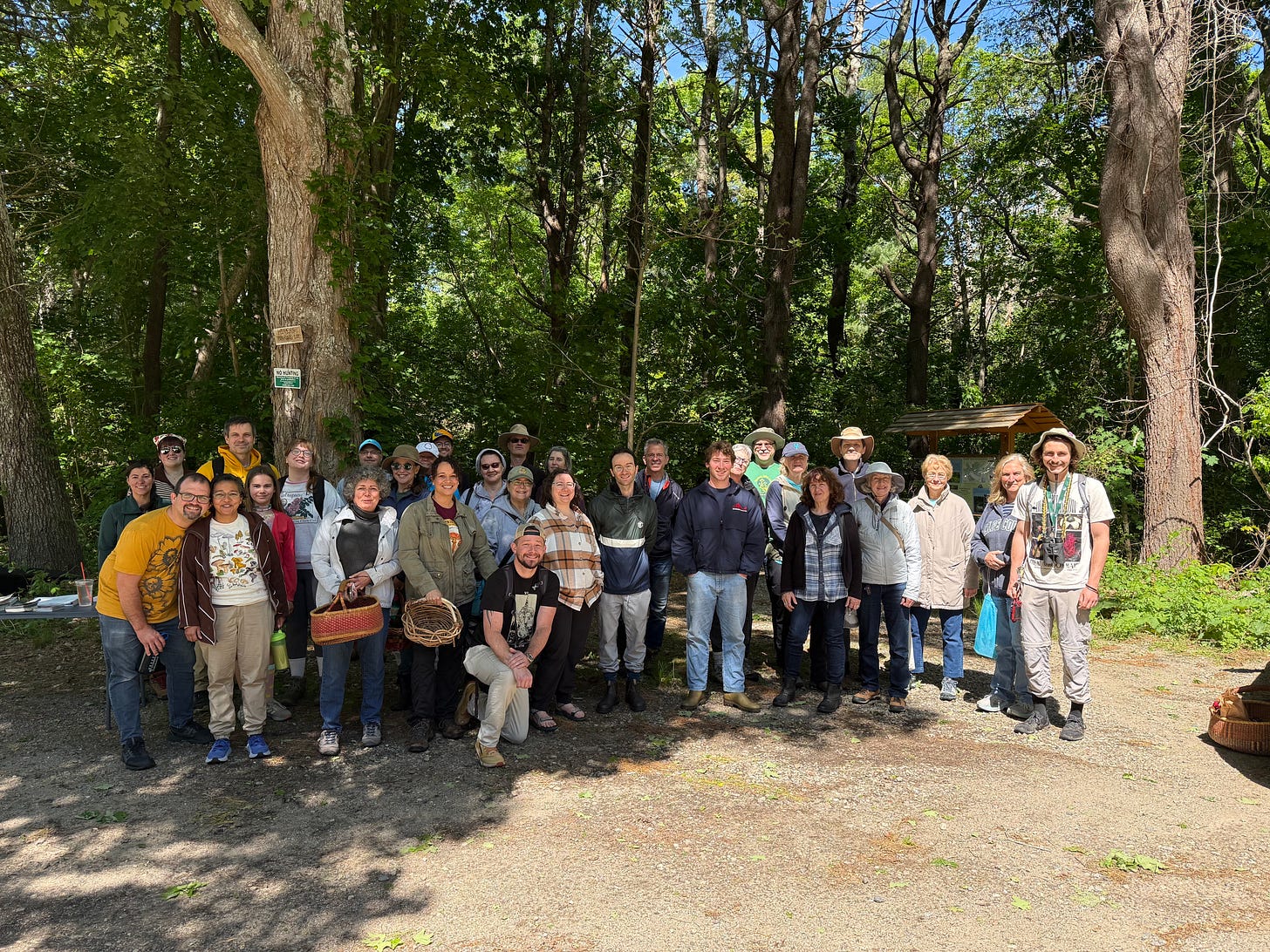Good evening, friends,
This week we’re going back to the burn to examine another peculiar little mushroom. I found these burn beacons near last week’s charcoal eyelash cups in an area of Sterling Forest State Park, NY where a wildfire raged last fall. The mushroom was identified by the New York Mycological Society president, Ethan Crenson, who has found this fungus once before in the Bronx.
These mushrooms don’t have a common name, but I thought “burn beacons” might be appropriate due to their color. The name is also a nod to the somewhat closely related swamp beacons (Mitrula elegans), as both species belong to the order Helotiales. Before we grind things to a halt with anymore taxonomy, let’s learn about what these mushrooms do in the woods and what they could potentially do inside us.
Fun Facts
There’s a researcher in China, Shuai Zong, who seems to be particularly interested in Lachnum fungi and the novel compounds (aka “natural products”) they produce. He and his colleagues have conducted dozens of studies on different species in the genus and have focused their research on a group of Lachnum polysaccharides (LEPs) that have demonstrated anti-cancer properties.
In one study, LEPs inhibited the growth of colon cancer in mice and also mitigated some of the negative side effects (weight loss, inflammation) of the cancer. Further, LEP consumption helped boost beneficial bacteria and reduce harmful bacteria in the guts of these mice. A different study in mice found that LEPs were able to turn “tumor associated macrophages” (white blood cells associated with tumor progression) back into white blood cells that could actually kill tumor cells.
It’s fascinating how a fungus that lives entirely within soil and/or plants (we’ll learn more about that below) can produce compounds that have anti-tumor properties in mammals. More research is needed to determine whether these LEPs could be effective in cancer treatment for humans, but the early research is promising.
The etymology of Lachnum comes from the Greek lachnos which means “wool” or “fluff”. This refers to the small, wooly hairs that can be found on the stipes of some mushrooms in the genus. The term to describe these dense, small hairs is floccose. The species epithet pygmaeum comes the Latin pygmaeus and means “small”, a reference to the size of these mushrooms which top out at 1 cm in height.
Ecology
How the fungus lives in the forest isn’t entirely understood, but studies suggest it can exist as an endophyte, living entirely within a plant, or as endomycorrhizal partner where the fungus forms a mutualistic association with a plant partner. One study out of British Columbia found that a Lachnum species lived entirely within the needles of spruce trees (Reference 3).
In the instance of the endomycorrhizal relationship, the fungus wraps around the root hairs of the plant partner and then penetrates the plant cells to establish a direct nutrient exchange. The plant provides the fungus with sugars produced through photosynthesis while the fungus is able to give the plant water and other minerals that aren’t easy for the plant to uptake.
Digging a little deeper, it looks like L. pygmaeum specifically associates with plants in the family Ericaceae — rhododendrons, blueberries, and other plants that prefer acidic, nutrient poor soil. I’d speculate that the burn beacons I found were growing out of the base of a lowbush blueberry (Vaccinium angustifolium).
The fact that they were popping right out of the base of the scorched stem is of note. This appears to be their typical growth habit in the other observations I found on MushroomObserver and iNaturalist. Many of these other observations also occur in areas that recently burned. I imagine when the fungus’s plant partner dies in a fire, the fungus produces mushrooms to send spores elsewhere with the hopes of finding a new, living mycorrhizal partner.

If you want to find this ascomycete fungus it looks like you should head to recently burned areas with ericaceous plants. The mushroom has been found in North America, Europe, Asia, and Australia, and fruits the growing season after a fire.
CCMS and the Maine Fungi Fest
This past weekend we had our first Cape Cod Mycological Society walk and a whopping 30 people showed up. A great success and our next walk is scheduled for June 2nd in Yarmouth, MA. Visit the website or join the Facebook group here to keep up with the club.
This weekend I’ll be up in Maine for the Maine Fungi Fest and I will recap that next week. Enjoy these last few days of May and it looks like we have some rain on the way,
Aubrey
References:
Zong S, Ye H, Ye Z, He Y, Zhang X, Ye M. Polysaccharides from Lachnum sp. Inhibited colitis-associated colon tumorigenesis in mice by modulating fecal microbiota and metabolites. Int Immunopharmacol. 2022 Jul;108:108656. doi: 10.1016/j.intimp.2022.108656. Epub 2022 Apr 4. PMID: 35390743.
Zong S, Li J, Ye Z, Zhang X, Yang L, Chen X, Ye M. Lachnum polysaccharide suppresses S180 sarcoma by boosting anti-tumor immune responses and skewing tumor-associated macrophages toward M1 phenotype. Int J Biol Macromol. 2020 Feb 1;144:1022-1033. doi: 10.1016/j.ijbiomac.2019.09.179. Epub 2019 Oct 25. PMID: 31669462.
McMullin DR, Green BD, Prince NC, Tanney JB, Miller JD. Natural Products of Picea Endophytes from the Acadian Forest. J Nat Prod. 2017 May 26;80(5):1475-1483. doi: 10.1021/acs.jnatprod.6b01157. Epub 2017 Apr 11. PMID: 28398744.
https://mushroomobserver.org/observations?pattern=lachnum+pygmaeum










Love this! Reminds me of the foraged chicken of the woods mushroom recipe I made inspired from my Appalachian Trail thru hike. check it out:
https://thesecretingredient.substack.com/p/what-my-great-grandfathers-memoir